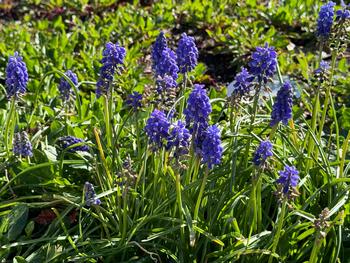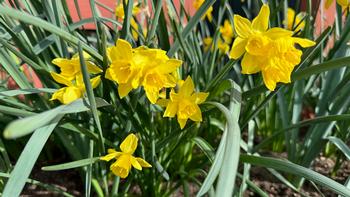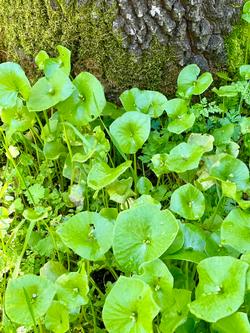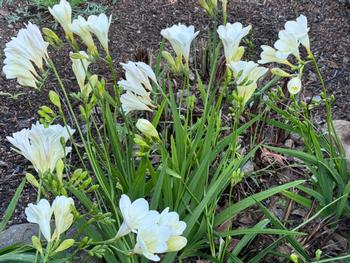Spring 2024
A Simple Strategy for a Firewise Garden
Living in Wildfire Country by Marilyn Saarni

What are ephemerals? Plants that sprout leaves and flowers in the California coastal winter and spring, and then fade away by the time hot and windy weather arrives and wildfire risk increases. Maintenance is simple too: plant in a timely way (usually fall), sprinkle water on sprouts and seedlings in case we have a long dry spell in winter, enjoy their blooms, and as they die back trim, collect seeds if desired, and maybe mulch over with non-flammable, well-rotted compost for the summer and fall peak fire season.

To bring a smile to you and others who visit your garden, spring bulbs are the best! And great firewise garden plants. Daffodils, narcissus, freesias, grape hyacinths, and hyacinths are all standouts here—and deer and gophers mostly leave them alone. Tulips and crocus are all wonderful too—but also popular with gophers. If you have gophers harvesting in your garden, pot these bulbs up!
Maintenance: Leave these bulbs untouched from bloom until their leaves are yellowing, and then cut them to the ground. If they naturalize, and if you want to expand or give some away, dig them up before the rainy season starts, divide the bulbs, and replant. Or lift early and store them in a cool, dry, dark place until October-December, our prime traditional spring bulb planting time. (Most tulips require chill hours, and won’t naturalize.)

Maintenance: Most of these have specific growing requirements, so research their needs before selecting. However, if planted at the right time and where they’re happy, you just let them shine after that! Many of these require NO SUMMER WATER. They have evolved to expect a dry California summer, and will rot if they get summer soaks. Many people plant their demanding Calochortus bulbs in pots for this reason, tucking the pots out of reach of summer irrigation when they have finished blooming. Some of these natives grow on slopes in fast-draining soils, so if you have a paver path or firebreak weaving through your garden, tuck a few in along the edges. Just about all of these bulbs need to be planted in the fall or early winter at the latest. Sometimes in spring you’ll find potted, blooming plants in nurseries—a bit of instant gratification. If you indulge, may these inspire you to add more in the fall.

Maintenance: While the timing for the different species may differ, if you withdraw water for the hot summer weather, they’ll quickly die down. Harvest seeds as you wish, or let them cast their own (if they like your garden, expect lots of new plants next spring!), and then cut to the ground.
The plants listed here have relatively low flammability, likely turning into ash when exposed to embers, and are not big enough to build up deadly fuel loads. They’re easy to maintain, and after they die back, their dry debris cleans up quickly. They can also act as early-spring low fillers for island plantings where you cut back your woodier plants (like Salvias) for winter or pruned large shrubs to open them up. These ephemerals will support the early spring pollinators that often struggle to find enough food after winter, and then fade while your shrubs fill in. Best of all, they’ll boost your joy that spring has returned with all of its lushness and color. By all means, explore other options. Just remember: look for that Mediterranean ecosystem trait of quick spring bloom and summer dormancy.
A great resource for general firescaping. Valachovic Y., S. L. Quarles, S. V. Swain (2021). Reducing the Vulnerability of Buildings to Wildfire: Vegetation and Landscaping Guidance. UCANR Publication 8695. https://anrcatalog.ucanr.edu/pdf/8695.pdf

